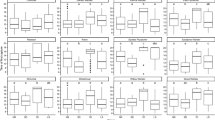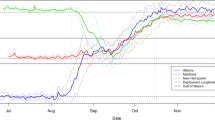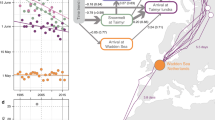Abstract
To African–Palearctic migratory birds that spend the non-breeding season in sub-Saharan Africa, the Sahara desert is an ecological barrier that must be crossed using large energy reserves stored at stopover sites either side. Given the coincidence of spring migration with the height of the dry season in the west African Sahel, spring stopover conditions may be a limiting factor that regulates populations. By determining where, when and how reserves are accumulated prior to crossing the desert, we can identify possible population regulation mechanisms in Palearctic migrants and effectively target stopover sites for protection. We present data on the non-breeding season use of Djoudj National Park in the western Sahel by 38 Palearctic migrants based on constant effort mist-netting data. Twenty-four species showed evidence of using Djoudj either throughout the non-breeding period or during spring migration. The remaining 14 species were largely absent from Djoudj and presumably accumulated energy reserves for spring migration south of the Sahel. Species preparing for spring migration at Djoudj began increasing their energy reserves in January or February. Energy reserves were generally accumulated at slow rates during long stopovers, and in all species examined, predicted take-off fuel loads were sufficient to cross the Sahara desert under certain conditions. Three species, Common Redstart Phoenicurus phoenicurus, Common Whitethroat Sylvia communis and Common Blackcap Sylvia atricapilla, achieved faster rates and had concurrently lower stopover durations. We predict that vulnerability to fluctuating environmental conditions in the Sahel region is greater in species that initiate fuelling later in the spring and in species with short stopover durations.
Zusammenfassung
Auftanken für die Sahara-Überquerung—Variation bei der Gebietsnutzung und in Beginn und Ausmaß der Gewichtszunahme im Frühling bei achtunddreißig paläarktischen Zugvogelarten im westlichen Sahel.
Für Zugvögel, die in der Paläarktis brüten und im subsaharischen Afrika überwintern, stellt die Sahara eine ökologische Barriere dar, für deren Überwindung sie große Energiereserven benötigen, die sie bei Zwischenstopps auf beiden Seiten einlagern. Da der Frühjahrszug mit dem Höhepunkt der Trockenzeit in der westafrikanischen Sahelzone zusammentrifft, könnten die dortigen Rastbedingungen im Frühjahr einen limitierenden, die Populationen regulierenden Faktor darstellen. Kann man ermitteln, wann, wo und wie die Energiereserven vor der Überquerung der Wüste angelegt werden, lassen sich mögliche Mechanismen der Populationsregulation bei paläarktischen Zugvögeln ausmachen und Rastplätze gezielt schützen. Hier präsentieren wir Daten über die Nutzung des Djoudj Nationalparks als Winterquartier durch 38 paläarktische Zugvogelarten, die auf der Grundlage standardisierter Netzfänge gewonnen wurden. Vierundzwanzig Arten nutzten Djoudj entweder während der ganzen Überwinterungszeit oder auf dem Frühjahrszug. Die restlichen 14 Arten suchten Djoudj kaum auf und legten ihre Energiereserven für den Frühjahrszug vermutlich südlich der Sahelzone an. Arten, die sich in Djoudj für den Frühjahrszug rüsteten, begannen im Januar oder Februar mit der Aufstockung ihrer Energiereserven. Diese wurden in der Regel allmählich während längerer Rastaufenthalte angelegt; bei allen untersuchten Arten waren die geschätzten Energiereserven beim Abflug ausreichend, um die Sahara unter bestimmten Bedingungen zu überqueren. Drei Arten—Gartenrotschwanz Phoenicurus phoenicurus, Dorngrasmücke Sylvia communis und Mönchsgrasmücke Sylvia atricapilla—erreichten schnellere Zunahmeraten und hatten folglich kürzere Verweildauern. Unsere Prognose wäre eine größere Anfälligkeit für veränderliche Umweltbedingungen in der Sahelzone bei Arten, die erst später im Frühling auftanken.






Similar content being viewed by others
References
Alerstam T (1990) Bird Migration. Cambridge University Press, Cambridge
Atkinson PW, Clark NA, Bell MC, Dare PJ, Clark JA, Ireland PL (2003) Changes in commercially fished shellfish stocks and shorebird populations in the Wash, England. Biol Conserv 114:127–141
Atkinson PW, Baker AJ, Bennett KA, Clark NA, Clark JA, Cole KB, Dekinga A, Dey A, Gillings S, González PM, Kalasz K, Minton CDT, Newton J, Niles LJ, Piersma T, Robinson RA, Sitters HP (2007) Rates of mass gain and energy deposition in red knot on their final spring staging site is both time- and condition-dependent. J Appl Ecol 44:885–895
Baillie SR, Peach WJ (1992) Population limitation in Palearctic–African migrant passerines. Ibis 134:120–132
Bayly NJ, Rumsey SJR (2010) Garden Warbler Sylvia borin migration in sub-Saharan west Africa. Ringing Migr 25:59–61
Bayly NJ, Clark JA, Rumsey SJR (2011) Crossing the Sahara Desert – migratory strategies of the grasshopper warbler Locustella naevia. J Ornithol 152:933–946
Biebach H (1992) Flight-range estimates for small trans-Saharan migrants. Ibis 134(suppl):47–54
BirdLife International (2004) Birds in Europe: population estimates, trends and conservation status. BirdLife international, Cambridge
Borrow N, Demey R (2004) Birds of Western Africa. Christopher Helm, London
Burnham KP, Anderson DR (1998) Model selection and inference: A practical information theoretic approach. Springer, New York
Busse P, Kania W (1970) Operation Baltic 1961–1967 working methods. Acta Ornithol 12:231–267
Cramp et al. (ed) (2004) Birds of the Western Palearctic interactive. Oxford University Press, Oxford
Dierschke V (2003) Predation hazard during migratory stopover: are light or heavy birds under risk? J Avian Biol 34:24–29
Efford MG (2005) Migrating birds stop over longer than usually thought: comment. Ecology 86:3415–3418
Erni B, Liechti F, Bruderer B (2002) Stopover strategies in passerine bird migration: a simulation study. J Theor Biol 219:479–493
Fewster RM, Buckland ST, Siriwardena GM, Baillie SR, Wilson JD (2000) Analysis of population trends for farmland birds using generalized additive models. Ecology 81:1970–1984
Fransson T, Jakobsson S, Kullberg C, Mellroth R, Petrersson T (2006) Fuelling in front of the Sahara desert in autumn—an overview of Swedish field studies of migratory birds in the eastern Mediterranean. Ornis Svec 16:74–83
Hahn S, Bauer S, Liechti F (2009) The natural link between Europe and Africa—2.1 billion birds on migration. Oikos 118:624–625
Hedenström A, Alerstam T (1997) Optimum fuel loads in migratory birds: distinguishing between time and energy minimization. J Theor Biol 189:227–234
Hernandez A (2009) Summer-autumn feeding ecology of pied flycatchers Ficedula hypolueca and spotted flycatchers Muscicapa striata: the importance of frugivory in a stopover area in north-west Iberia. Bird Conserv Int 19:224–238
Hjort C, Pettersson J, Lindström Å, King JMB (1996) Fuel deposition and potential flight ranges of blackcaps Sylvia atricapilla and whitethroats Sylvia communis on spring migration in The Gambia. Ornis Svecica 6:137–144
Jordano P (1988) Diet, fruit choice and variation in body condition of frugivorous warblers in Mediterranean scrubland. Ardea 76:193–209
Klaassen M, Lindström A (1996) Departure fuel loads in time-minimising migrating birds can be explained by the energy costs of being heavy. J Theor Biol 183:29–34
Liechti F, Schmaljohann H (2007) Wind-governed flight altitudes of nocturnal spring migrants over the Sahara. Ostrich 78:337–341
Moreau RE (1972) The Palearctic-African bird migration systems. Academic, London
Morel GJ, Morel M (1992) Habitat use by Palearctic migrant passerine birds in West Africa. Ibis 134(suppl):83–88
Newton I (2004) Population limitation in migrants. Ibis 146:197–226
Newton I (2006) Can conditions experienced during migration limit the population levels of birds? J Ornithol 147:146–166
Ockendon N, Hewson CM, Johnston A, Atkinson PW (2012) Declines in British breeding populations of Afro-Palaearctic migrant birds are linked to bioclimatic wintering zone in Africa, possibly via constraints on arrival time advancement. Bird Study. doi:https://doi.org/10.1080/00063657.2011.645798
Ottosson U, Rumsey R, Hjort C (2001) Migration of four Sylvia warblers through northern Senegal. Ringing Migr 20:344–351
Ottosson U, Bairlein F, Hjort C (2002) Migration patterns of Palaearctic Acrocephalus and Sylvia warblers in north-eastern Nigeria. Vogelwarte 41:249–262
Ottosson U, Waldenstrom J, Hjort C, McGregor R (2005) Garden warbler Sylvia borin migration in sub-Saharan West Africa: phenology and body mass changes. Ibis 147:750–757
Pennycuick CJ (2008) Modelling the flying bird. Elsevier, Amsterdam
Pradel R, Hines JE, Lebreton JD, Nichols JD (1997) Capture–recapture survival models taking account of transients. Biometrics 53:60–72
Redfern C, Topp V, Jones P (2004) Fat and pectoral muscle in migrating sedge warblers Acrocephalus schoenobaenus. Ringing Migr 22:24–34
Salewski V, Schaub M (2007) Stopover duration of Palearctic passerine migrants in the western Sahara—independent of fat stores? Ibis 149:223–236
Salewski V, Kéry M, Herremans M, Liechti F, Jenni L (2009) Estimating fat and protein fuel from fat and muscle scores in passerines. Ibis 151:640–653
Salewski V, Schmaljohann H, Liechti F (2010) Spring passerine migrants stopping over in the Sahara are not fall-outs. J Ornithol 151:371–378
Sanderson FJ, Donald PF, Pain DJ, Burfield IJ, van Brommel FPJ (2006) Long-term population declines in Afro-Palearctic migrant birds. Biol Conserv 131:93–105
Sauvage A, Rumsey SJR, Rodwell SP (1998) Recurrence of Palearctic birds in the lower Senegal river valley. Malimbus 20:33–53
Schaub M, Jenni L (2000a) Body mass of six long-distance migrant passerine species along the autumn migration route. J Ornithol 141:441–460
Schaub M, Jenni L (2000b) Fuel deposition of three passerines along the migration route. Oecologia 122:306–317
Schaub M, Pradel R, Jenni L, Lebreton JD (2001) Migrating birds stop over longer than usually thought: an improved capture–recapture analysis. Ecology 82:852–859
Schmaljohann H, Liechti F, Bruderer B (2007) Songbird migration across the Sahara: the non-stop hypothesis rejected! Proc R Soc Lond B 274:735–739
Schmaljohann H, Liechti F, Bruderer B (2009) Trans-Sahara migrants select flight altitudes to minimize energy costs rather than water loss. Behav Ecol Sociobiol 63:1609–1619
Schwilch R, Jenni L (2001) Low initial refuelling rate at stopover sites: a methodological effect? Auk 118:698–708
Sillett TS, Holmes RT (2002) Variation in survivorship of a migratory songbird throughout its annual cycle. J Anim Ecol 71:296–308
Stoate C, Moreby SJ (1995) Premigratory diet of trans-Saharan migrant passerines in the western Sahel. Bird Study 42:101–106
Svensson L (1992) Identification guide to European Passerines, 4th edn. Naturhistoriska, Stockholm
Weber T, Houston AI, Ens B (1999) Consequences of habitat loss at migratory stopover sites: a theoretical investigation. J Avian Biol 30:416–426
White GC, Burnham KP (1999) Program MARK: survival estimation from populations of marked animals. Bird Study 46(suppl):120–139
Wilson JM, Cresswell W (2006) How robust are Palearctic migrants to habitat loss and degradation in the Sahel. Ibis 148:789–800
Winstanley D, Spencer R, Williamson K (1974) Where have all the whitethroats gone? Bird Study 21:1–14
Yohannes E, Biebach H, Nikolaus G, Pearson DJ (2008) Passerine migration strategies and body mass variation along geographic sectors across East Africa, the Middle East and the Arabian Peninsula. J Ornithol 150:369–381
Acknowledgments
We thank all the ringers who took part in the Wetland Trust expeditions to Djoudj National Park between 1990 and 1993. We are indebted to Phil Jones for digitising large volumes of ringing data and to Jacquie Clark for commenting on the manuscript. H. Schmaljohann and an anonymous reviewer provided invaluable comments that helped improve the manuscript.
Author information
Authors and Affiliations
Corresponding author
Additional information
Communicated by F. Bairlein.
Electronic supplementary material
Below is the link to the electronic supplementary material.
Rights and permissions
About this article
Cite this article
Bayly, N.J., Atkinson, P.W. & Rumsey, S.J.R. Fuelling for the Sahara crossing: variation in site use and the onset and rate of spring mass gain by 38 Palearctic migrants in the western Sahel. J Ornithol 153, 931–945 (2012). https://doi.org/10.1007/s10336-012-0823-5
Received:
Accepted:
Published:
Issue Date:
DOI: https://doi.org/10.1007/s10336-012-0823-5




